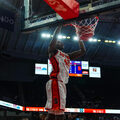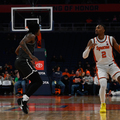In ending 48-year NCAA title drought, Cornell parallels legendary 1977 team
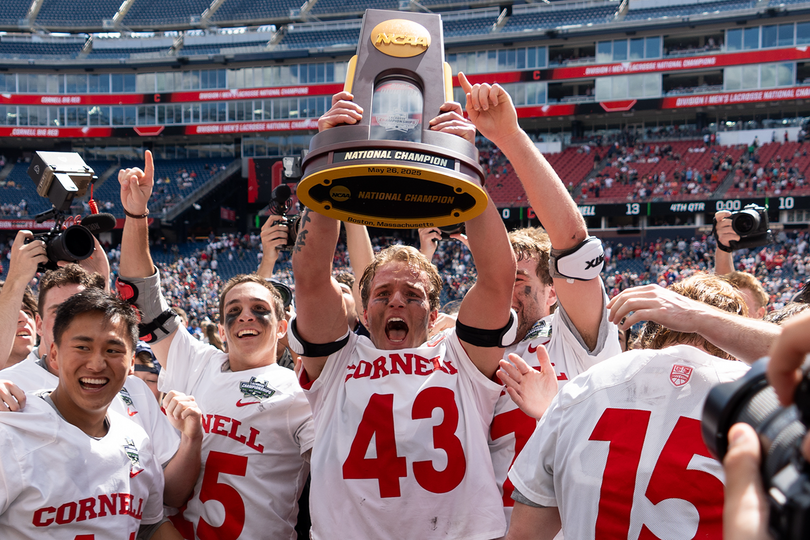
Cornell's 2025 NCAA Championship revived feelings of reaching eternal glory that once ran rampant in the 1970s under legendary head coach Richie Moran. Jacob Halsema | Staff Photographer
Get the latest Syracuse news delivered right to your inbox. Subscribe to our sports newsletter here.
FOXBOROUGH, Mass. — John Griffin can’t think about 1977 without pondering the pain of 1978. Cornell, riding a program-record 42-game winning streak and back-to-back NCAA titles into the 1978 national championship game, lost to Johns Hopkins in a 13-8 demolition.
The defeat doesn’t overcome 68-year-old Griffin, but it nags at him. The former star Cornell goalie allowed more goals that afternoon in Piscataway, New Jersey than he had in a game all season. He continuously replays the loss in his head, searching for answers to a problem he can’t solve.
“The thing that was so bitter and difficult to accept at the time, was the feeling of, ‘What could I have done more to not let my teammates, my coaches and the entire fanbase experience that hurt?’” Griffin said. “Life goes on, right? But for a period of time, it was difficult to swallow.”
Griffin and his teammates never got the chance to exact their revenge. Now, he’s just glad Cornell’s 2025 squad did.
Four seasons ago, the Big Red, who hadn’t won an NCAA Championship since 1977, battled Maryland for the 2022 title in East Hartford, Connecticut. UMD silenced Cornell’s electric offense in a 9-7 Big Red loss. Over the next two years, a freshman class led by CJ Kirst and Wyatt Knust steadily developed into stars, despite failing to reach Memorial Day in each of those seasons.
“We really used that as fuel for this year,” said Knust, Cornell’s senior starting goalie.
In the final season with its 16-man senior class, Cornell lost one game in 2025 and set a program-record for wins en route to qualifying for the Final Four in Foxborough. Of course, that meant another date with the Terrapins — today’s gold standard in Division I lacrosse.
And on Monday, the Big Red used 48 years of pent-up frustration to play a near-perfect game and conquer their 2022 demons.
No. 1 seed Cornell defeated No. 2 seed Maryland 13-10 in the 2025 NCAA Championship game at Gillette Stadium for the program’s first national title since 1977. Behind a six-goal masterclass from Kirst, the Final Four’s Most Outstanding Player, the Big Red forced the tactically sound Terrapins into a game they didn’t want to play — one filled with turnovers, clearing issues and a showcase of Cornell’s supreme talent. The parallels between the 1977 team and this one are abundant, but 2025’s group acts as the connector between two eras of greatness.
Ithaca is a city of champions once again. For Cornell’s 31-year-old head coach Connor Buczek, that’s simply the standard.
“Everybody is held to task. Everybody is demanded. So for every one of those guys, if they are not doing it themselves, they can’t hold anybody else to that standard. That is a Cornell lacrosse tradition thing. That is a culture thing. That’s something that we didn’t build,” Buczek said postgame Monday. “We are very fortunate that when you get the right collection of people that really demand and push and encourage and get a lot out of their teammates, our job is really easy.”
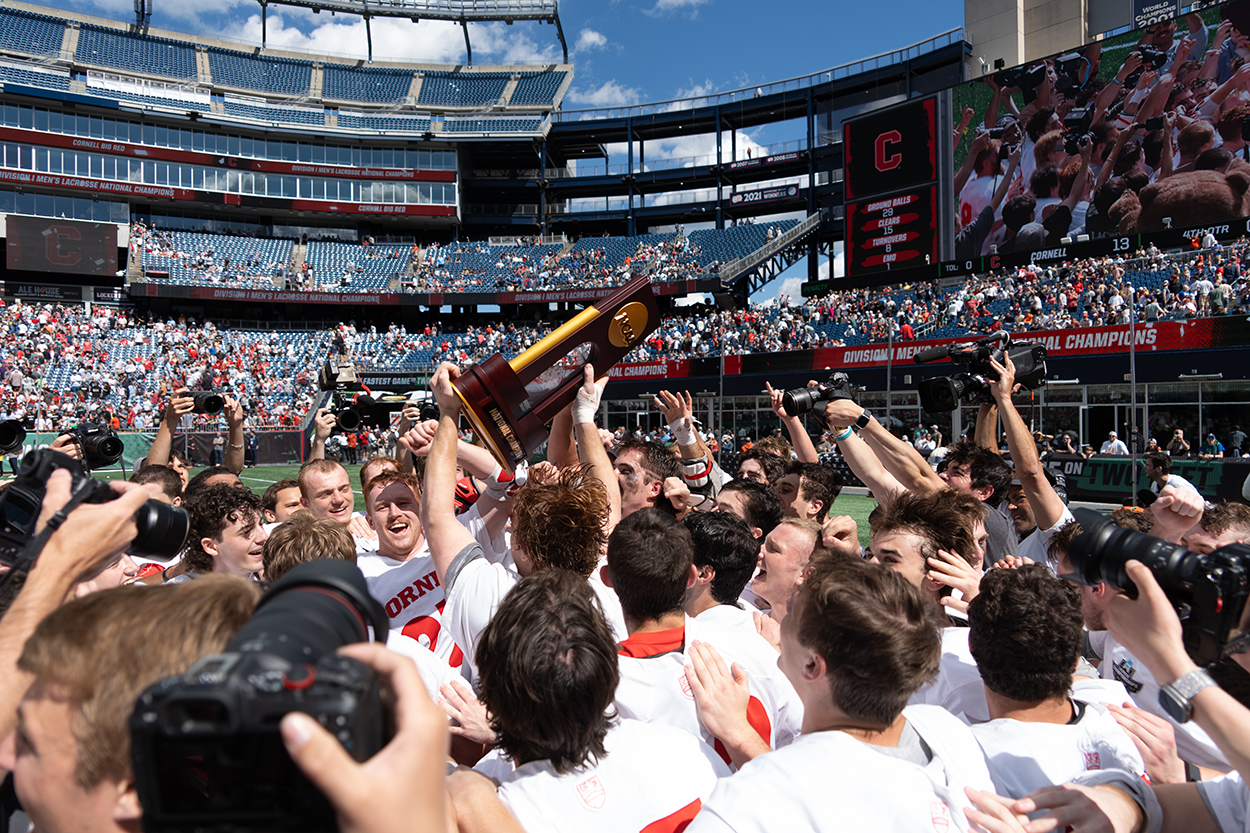
Cornell raises the 2025 National Championship trophy in the air after the final buzzer sealed its victory. The Big Red’s 13-10 win over Maryland broke their 48-year title drought. Jacob Halsema | Staff Photographer
• • •
Richie Moran established Cornell’s program in the modern era of college lacrosse. In 29 seasons from 1969-97, the legendary head coach won three NCAA Championships, posted a 257-121 record and captured 15 Ivy League titles. Moran’s most successful period spanned from 1976-77, when the Big Red went two full seasons without losing a contest.
Griffin said Moran recruited players from similar areas — Baltimore, central and upstate New York and Long Island being the most prominent — which allowed coinciding personalities to mix in the Big Red locker room. Moran’s compassion is why they chose Cornell, but his relentlessness is how they built a legacy.
Though Moran was no drill sergeant, Griffin said, his enormous personality and extreme attention to detail laid the bedrock for Cornell’s unbreakable culture.
In other words, Moran’s players would do anything for him.
“If Richie asked me to run through a wall for him at the time, and even now, there’d be absolutely zero hesitancy,” Griffin said. “A lot of my teammates probably felt the same way.”
Before games, Moran would find a few players and hit them with one of his many one-liners, Griffin said. The former goalie recalls one time before a game when Moran pulled him aside as the Big Red walked one-by-one out of the locker room.
“He sees me coming in, and he says, ‘Hey big boy, get ready,’” Griffin said. “And the thing is, he would say that and you would look at him, and his eyes were popping out of his head more than anybody else.”
Griffin didn’t take it personally, because he knew it was Moran’s way of telling him we need you today. For Griffin, Moran’s encouragement was all he needed.
“The care and love for the coaches, and for (Moran) in particular, is what drove me to try and do whatever I could in a positive way to contribute to the team’s success,” Griffin said.
Griffin was always driven by Moran’s words, considering the head coach’s intensity was through the roof.
He remembers Moran making the team run sprints up and down the Schoellkopf Field stairs whenever the Big Red practiced poorly. Players usually didn’t fight back, Griffin said. They knew they deserved it; everything Moran did, he did for a reason.
That includes the “sweat hog run.”
It’s a tradition Moran enacted whenever he thought his players were “dogging it” in practice, Griffin said. A typical “sweat hog run” featured a two-to-three mile trek through Cornell’s hilly campus, past the dormitories and up North Campus and back. If need be, Moran regularly began practices with the run. Griffin said, as tough as it was, players took each run head-on, motivated by improvement.
There wasn’t time to sulk in Moran’s program — you were either all-in or all-out. Griffin misses being all-in on Moran’s message.
“I loved it,” Griffin said of Cornell’s practices. “It was great to be out there with your best buddies and trying to get better.”
Moran bringing in a collection of top-flight players is what Griffin believes is the No. 1 reason for the Big Red’s mid-70s surge. He didn’t think any team in the country could compete with Cornell’s sheer talent, especially on its 1977 squad.
The star names are endless: Bob Hendrickson manning the midfield; a killer at the faceoff X in Craig Jaeger; a ferocious defense led by Christopher Kane, Frank Muehleman and Robert Katz and an unabating attack featuring Thomas Marino, Steve Page and, most notably, Eamon McEneaney.
One of the best athletes in school history, McEneaney ranks second all-time in points at Cornell with 256. He was a two-time national champion. In 1977, he earned the Lt. Raymond Enners Memorial Award for the most outstanding player in D-I and captured the NCAA Tournament MVP en route to a title victory. If that wasn’t enough, he even starred as a tight end on the Big Red’s football team.
No one wanted to win more than McEneaney, Griffin said. The attack took that to a new level before the 1977 NCAA Championship game in Charlottesville, Virginia. Griffin said McEneaney was riled up before the battle with Johns Hopkins that Sunday afternoon. His energy was through the roof, and he could barely control himself.
To calm down, McEneaney woke up at 6:30 a.m. and went on a five-mile run. Burning off that excess energy led to McEneaney scoring three goals and dishing out five assists as he captained Cornell to an NCAA title victory.
McEneaney died in the Sept. 11, 2001, attacks at 46 years old. Accounts from the tragic day state McEneaney saved the lives of 63 people in the World Trade Center.
The memories of McEneaney’s lively spirit carry on to this day. He once said the team who wins a lacrosse game is the team that loves each other the most. Judging by the numerous warm embraces following Cornell’s 2025 national title, McEneaney’s words still ring true.
Buczek, a three-time All-American midfielder at Cornell, draws inspiration from the Moran-McEneaney days. He said Moran’s influence worked wonders for him when taking the Big Red head coaching gig before the 2020 season. Moran didn’t “ride into the sunset” upon retirement, Buczek said, and his involvement with the program helped the head coach get used to his new digs. Moran even spent time with Cornell’s current senior class during the 2022 season, a realization that piqued Buczek’s emotions.
Moran died on April 24, 2022. He was 85. Buczek is honored to bask in the culture Moran created and continue what the Hall of Famer started.
“I know he’s looking down on us smiling,” Buczek said.
If Moran had been in attendance Monday for Cornell’s championship christening, Buczek knows what he would’ve said.
“It’s great to be here,” Buczek said, invoking Moran’s signature phrase.
• • •
Dominance is how the Big Red won in the Moran era, and it was the theme of their 2025 season, too. Buczek’s team won more games (18) than any other Cornell men’s lacrosse team in history. Kirst tied the D-I single-season goal-scoring record with 82. Cornell players filled five-of-10 spots on the NCAA All-Final Four Team.
And the Big Red capped their historic campaign off with something that’s impossible for many: making Maryland look two steps behind.
“They have been the best team all year,” Terrapins 15-year head coach John Tillman said of Cornell. “They showed today why they are the No. 1 seed.”
Cornell exacted revenge from 2022 through a persistent attack and physical defense. Tillman said Cornell is the fastest team he’s faced all season. The Big Red switch from offense to defense quicker than anyone else and vice versa. He knew it’d be crucial to slow down Cornell’s transition offense and limit mistakes on the clear. Yet, even for the two-time NCAA Champion Tillman, that’s easier said than done.
The Terrapins turned the ball over 12 times compared to the Big Red’s eight. Maryland finished an uncharacteristic 17-for-21 on clears, including an abysmal 3-for-6 mark in the fourth quarter. Cornell stayed solid at the faceoff X, and while it lost the ground-ball battle, it won more 50/50 scuffles than UMD did. The Big Red even fooled star Maryland goalie Logan McNaney, who ended with a .458 save percentage. Every game in 2025 where McNaney finished at a save rate below .500, the Terrapins lost.
“At the end of the day, they just played a more complete game,” said Maryland defender Will Schaller, who guarded Kirst throughout the day.
Cornell’s attacking trio of Kirst, Ryan Goldstein and Michael Long proved too much for UMD to overcome. Kirst exploded for five second-half goals, continuously dodging around Schaller and perfecting mystifying finishes near the cage. Goldstein tallied four goals, using his innate speed and accuracy all game. Long didn’t score, though his two assists paid dividends.
Tillman said the Big Red essentially have three No. 1 attacks, which not even a team like the Terrapins have the resources to defend.
“It’s all just confidence and belief in your group,” Kirst added of Cornell’s execution. “In the second half, we’re all talking about that we had to play our game, and we had to draw slides, and we were able to put the ball in the back of the net.”
Cornell held a 12-9 lead with less than two minutes left, but Maryland’s Zach Whittier scored at the 1:22 mark to cut the deficit to two. The ensuing faceoff was crucial. UMD’s Jonah Carrier battled Cornell second-stringer Michael Melkonian at the X. A scrum for a ground ball broke following the initial clamp. As a sea of red and white jerseys charged at it, Big Red long pole Brendan Staub emerged from the pile cradling the ball in his stick.
At the same time, Buczek manically sprinted down Cornell’s sideline, begging the officials for a timeout. Once play stopped, Buczek gave Staub an emphatic, warm embrace.
“People ask me every game, ‘What’s the difference?’ It’s ground balls; our ability to pick the ball up off the turf,” Buczek said. “We preached it every day in practice. Today, they made the Cornell lacrosse tradition proud with their ground-ball effort.”
Pandemonium broke loose once the final buzzer sounded. Big Red players rushed to Knust’s cage for a celebratory dogpile. Feelings of eternal euphoria sprouted on the Gillette Stadium turf, seen through Kirst greeting his mother and Buczek holding onto his fiancé, Maddie Kiep, while tears streamed down their faces.
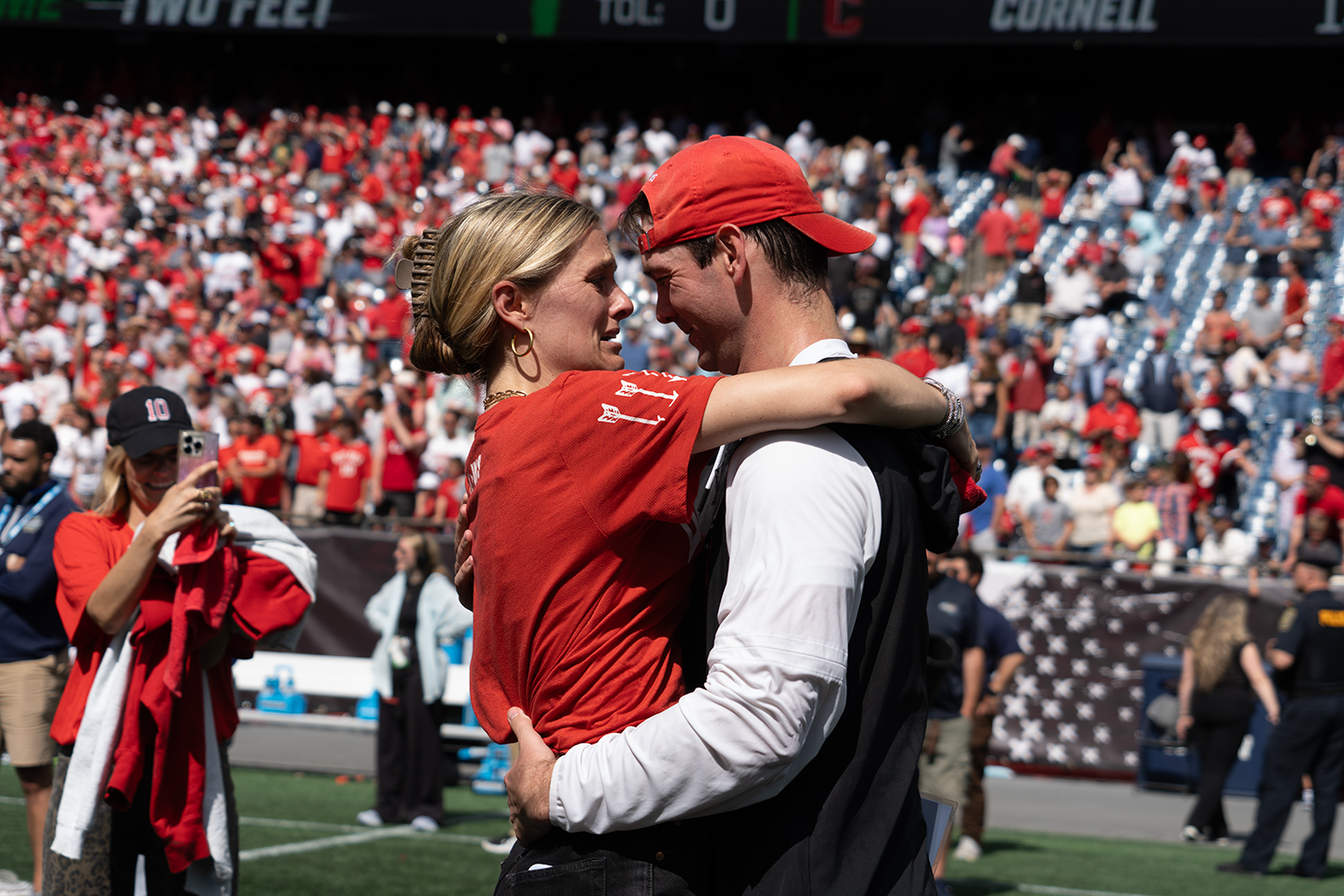
Cornell head coach Connor Buczek embraces his fiancé Maddie Kiep after the Big Red closed out their national championship Monday. Kiep played with Cornell women’s lacrosse from 2013-16, coinciding with Buczek’s All-American career with the Big Red. Jacob Halsema | Staff Photographer
For an almost-flawless performance, the jubilation was well deserved.
“You have to play as clean as possible. You have to can your opportunities. You have to be on point. And when we weren’t, they made us pay,” Tillman said of Cornell. “Again, they have been the best team all year.”
• • •
From Moran to Buczek, to McEneaney to Kirst, key figures of Cornell’s 1977 team were reincarnated in 2025.
Kirst, a happy-go-lucky guy who’s rarely seen with a frown, said he thought a lot about McEneaney’s legacy before the playoffs. Timeless stories of Big Red alumni are part of why Kirst chose Cornell in the first place. He quickly learned McEneaney was one of the greatest teammates possible, and he wanted to do the same for others.
After Cornell’s NCAA Semifinal win over Penn State on Saturday, in which Kirst was held to zero points for the first time in his career, Kirst said he spoke with Mike French — a Big Red star attack from 1974-76 and former teammate of McEneaney. The two shared a hug before French provided Kirst with words of wisdom heading into Monday’s title bout.
Kirst said he played the championship game for McEneaney, French and all those who came before him. It resulted in an NCAA title victory, ending his career passing McEneaney and French as Cornell’s all-time leading scorer.
“When you’re a freshman here, you learn that they are the best teammates ever,” Kirst said of Big Red legends like McEneaney, French and Rob Pannell. “They put a smile on someone else’s face in the locker room, and they are fearless competitors. To be a part of that tradition, it’s incredible.”
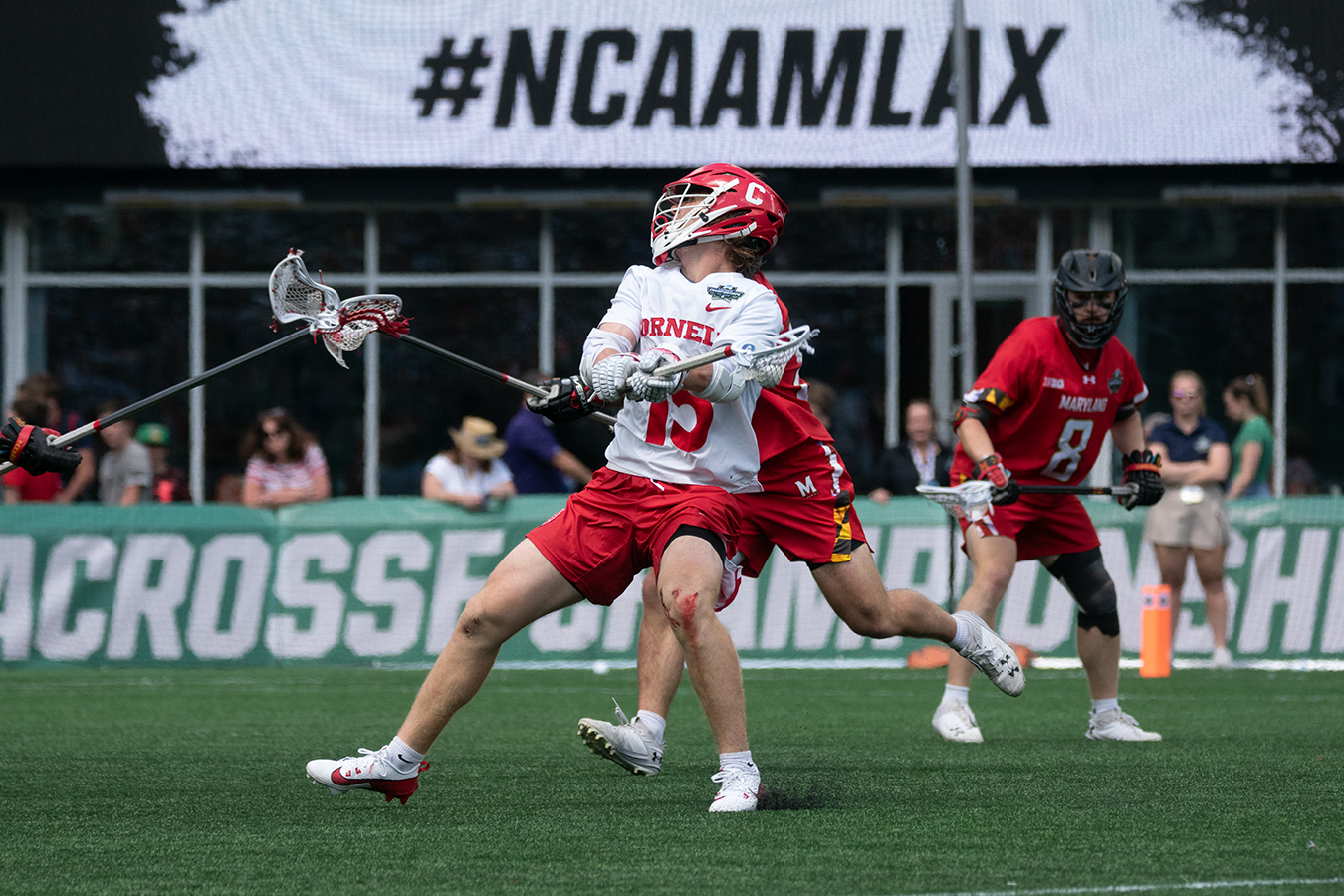
CJ Kirst winds up to fire a long strike at the net on Monday versus the Terrapins. Kirst emerged as the odds-on favorite for the Tewaraton Award this season and helped propel Cornell to its fourth national championship. Jacob Halsema | Staff Photographer
Buczek took pride in being the first head coach since Moran to bring Cornell an NCAA title. He wasn’t yet born during all three of Moran’s national championships, but it was the desire to bring the Big Red back to that era which made Buczek retire from the Premier Lacrosse League and become their head coach in 2020.
“He’s such an incredible man and (has) an incredible legacy,” Buczek said of Moran. “We are fortunate enough to uphold that legacy day-in and day-out.”
From afar, Buczek reminds Griffin of Moran. When he watches Buczek roam the sidelines with a baseball cap on, chewing gum and barking out orders, it’s nowhere near the same man Moran was — mostly due to age. However, they’re both laser-focused and unafraid to lay down the law when they know something’s going wrong, Griffin said.
“It’s a good, healthy intensity,” Griffin said of Buczek. “I guess it’s something that (Buczek and Moran) both had that translates in a positive way to their squad.”
Griffin, a 2008 inductee in the Cornell Athletics Hall of Fame, still supports the Big Red’s program. He watches every game he can, either on TV or after making trips back up to Ithaca. Before Monday’s national-title game, Griffin said he wouldn’t be attending since he’s recovering from knee replacement surgery. So he resorted to watching the ESPN broadcast.
He got to see Cornell avenge its 2022 NCAA title loss, something Griffin and his teammates couldn’t do a half-century ago. While he doesn’t know the 2025 team personally, Griffin can still tell how special the Big Red’s roster is. For him, he sees a reflection of 1977.
“I watch as closely as I can, and I say, ‘Boy, these guys seem like they’d be great teammates,’” Griffin said. “You never would have had this chance, but they seem like they’d be great dudes to have actually played with.”




